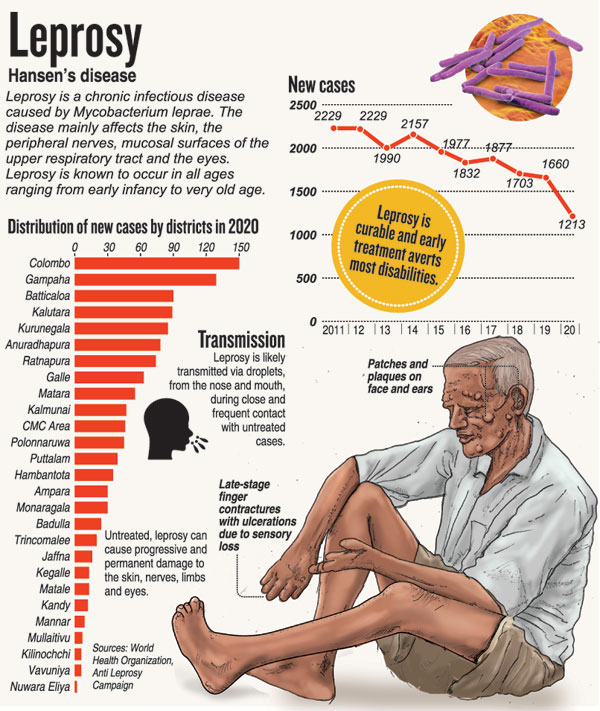News
Leprosy cases on the rise during pandemic; eradication deadline revised
Health officials’ preoccupation with the COVID-19 pandemic has led to a rise in the number of leprosy patients, impacting negatively the target set by the Anti-Leprosy Campaign (ALC) to eradicate leprosy by 2025.
This has prompted the ALC to revise its national strategic plan and set a new 2030 deadline.
Commemorating the World Leprosy Day on January 26, the ALC expressed concerns over the increasing number of leprosy patients in the country in the last two years. 
Director Dr. Champa Aluthweera said she believed there was an error in the figures indicated in the 2020 annual report which indicated a drastic drop of around 450 new patients compared to the previous year.
It is learnt that the total number of new cases identified in 2020 stood at 1290, compared to 1749 cases in 2019, but there had been no updates from district public health inspectors assigned to monitor the leprosy situation.
They had all been absorbed into the mainstream activities to control the covid pandemic spread.
As such, the district leprosy control team was unable to conduct mobile skin clinics, house-to-house surveys, awareness programmes, media campaigns and health staff training in the last two years resulting in an increase in the disease’s spread with several vulnerable areas reporting high prevalence of the disease, the director said.
She said the ALC’s launched an intensive campaign last month and it found leprosy pockets in certain regions, especially the Eastern and Western Provinces.
The worst affected had been the Batticoloa district with a record figure of more than 30 new cases so far this year. In the Western Province district of Gampaha, all members of a family at Wathupitiwala had been afflicted by leprosy.
Disease patterns indicated that those in the lower socioeconomic strata were more prone to contracting the disease, with doctors describing overcrowded households and poor sanitation as the main reasons for the fast spread.
The disease is spread by droplets from nasal sputum that is coughed out or sneezed.
According to the 2020 annual report, 441 women and 130 children were afflicted with the disease. In the 186 Eastern Province cases, 87 were women and 32 children.
The Western Province reported 414 new patients, including 168 women and 45 children.
These figures have led the ALC to suspect that there may be other pockets that need to be identified.
The alarming rise in numbers among women and children had turned the ALC’s attention towards schools and factories that employ women workers.
In pre-pandemic times, intensive campaigns had been conducted, screening women and children.
The World Health Organisation set a 2001 target to eliminate leprosy as a public health problem.
However Sri Lanka eliminated this target five years early, reducing the number of cases by less than one person in every 10,000 of its population in 1995.
Having reached its target the country adopted a lax approach by integrating the disease under the general health services providing treatments through dermatology clinics with the prevention aspect dealt by district control team.
This has resulted in 7 to 12 patients being reported for every 10,000 of its population in the past 20 years that followed, according to the ALC.
Also around 8 patients with grade 2 deformities had been reported every year during the period from 2001 to 2015. The figure increased to an alarming 10 patients in 2016.
However, an intensified campaign helped in the early detection and treatment of patients, leading to a reduction in the numbers afflicted with grade 2 deformities from 2017 to 2019.
The ALC said that there is a lack of awareness on the disease. As it is a skin disease that appears as a tiny patch without pain, many people tend to ignore the disease. Others seek treatment from general practitioners who treat patients for symptoms.
Early detection can cure the disease and prevent peripheral nerve damage that leads to deformity.
Children under 15 years have also been afflicted with the disease, with the numbers fluctuating at 10% of the total reported cases in the last 20 years. In 2022 the figure jumped to 10.7% with 130 children afflicted.
With the pandemic situation far from over, the ALC faces an uphill task to eradicate leprosy in the country by 2030.
The best way to say that you found the home of your dreams is by finding it on Hitad.lk. We have listings for apartments for sale or rent in Sri Lanka, no matter what locale you're looking for! Whether you live in Colombo, Galle, Kandy, Matara, Jaffna and more - we've got them all!

